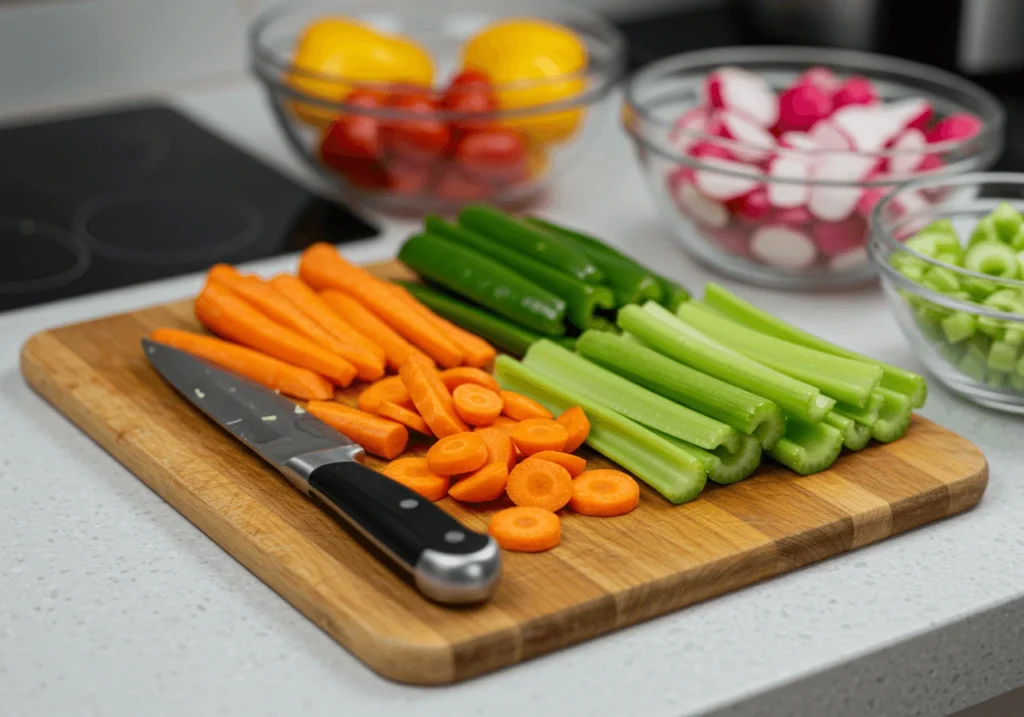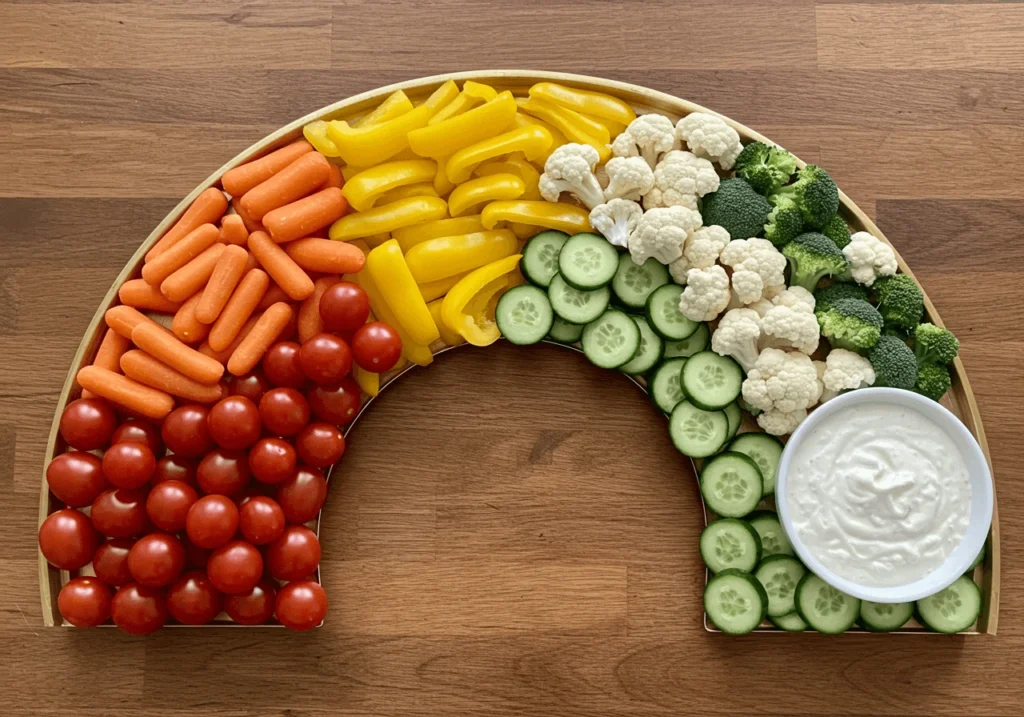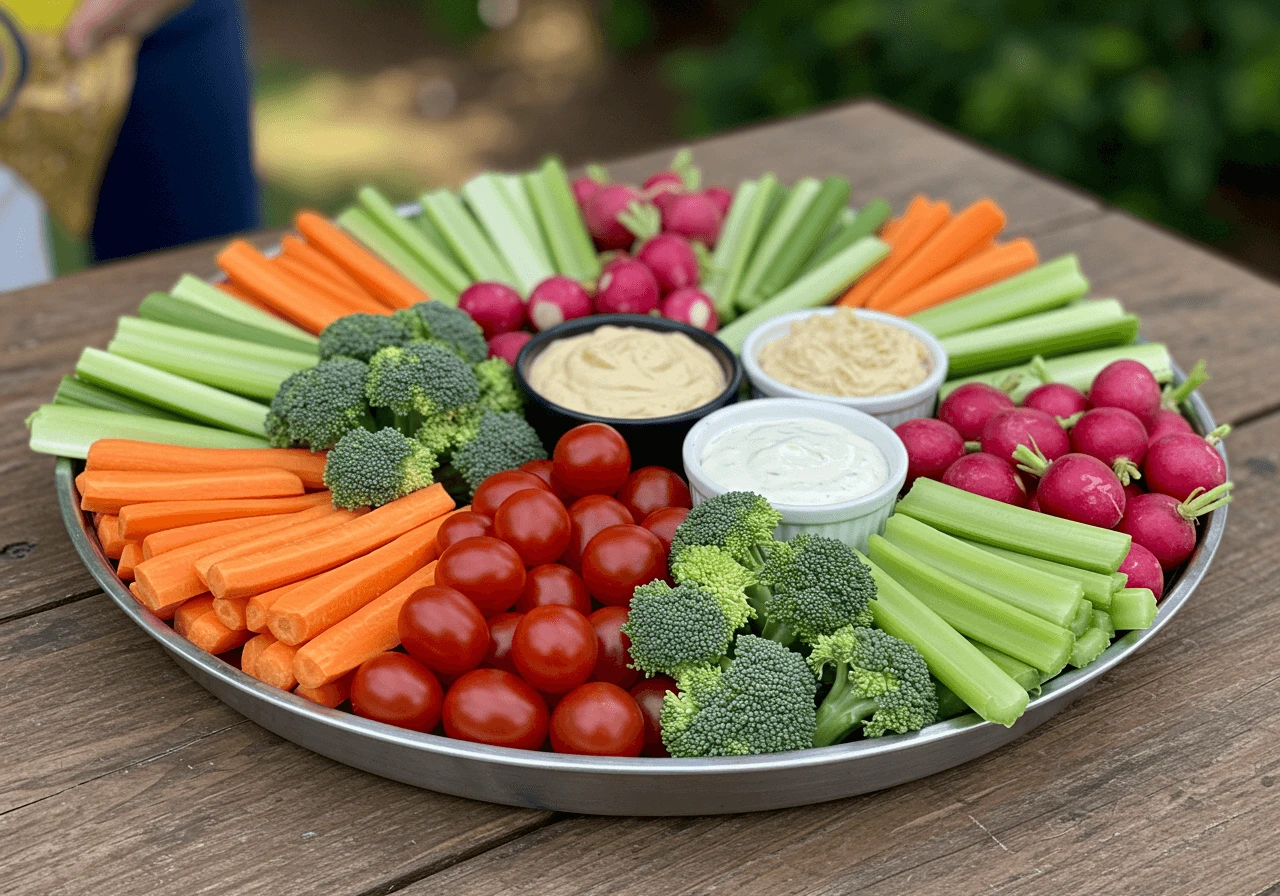Hosting a gathering and looking for a healthy, eye-catching appetizer? Look no further! A vegetable tray is not just a colorful feast for the eyes; it’s also a nutritious, versatile, and crowd-pleasing addition to any event. In this guide, we’ll dive into everything you need to know about creating the ultimate vegetable tray. From selecting the best vegetables to arranging them in a way that wows your guests, this article covers it all. Let’s begin with the basics!
Table of contents
- What is a Vegetable Tray?
- Benefits of Serving a Vegetable Tray
- How to Make a Vegetable Tray: Step-by-Step Guide
- What to Put on a Vegetable Tray: Essential Components
- How to Customize a Vegetable Tray for Different Themes
- Frequently Asked Questions (FAQs) About Vegetable Trays
- Pro Tips for Making the Perfect Vegetable Tray
- Where to Buy Ready-Made Vegetable Trays
- Budget-Friendly Tips for Vegetable Trays
- Conclusion: Why Every Gathering Needs a Vegetable Tray
What is a Vegetable Tray?
A vegetable tray, also known as a crudité platter, is a selection of fresh, raw vegetables arranged on a tray or platter, often served with dips or sauces. It’s a staple at parties, weddings, and family gatherings because of its simplicity and universal appeal.
Definition and Purpose
A vegetable tray is essentially a visually appealing arrangement of colorful, fresh vegetables, such as carrots, celery, cherry tomatoes, and broccoli. It’s served to provide a healthy snack option and balance out heavier, calorie-laden appetizers.
Vegetable trays aren’t just for health-conscious individuals—they’re for anyone who enjoys the crunch and natural flavor of fresh veggies. What’s more, they’re adaptable to any dietary preference, making them a great option for accommodating various guests.
Occasions to Serve a Vegetable Tray
You can’t go wrong with a vegetable tray when it comes to social events. It’s perfect for:
- Parties and celebrations: Think birthday parties, baby showers, and casual get-togethers.
- Potlucks: A vegetable tray is easy to transport and share.
- Healthy snacks: Whether for office lunches or an after-school snack, it’s a convenient and guilt-free choice.
- Holiday gatherings: Add a seasonal twist by incorporating themed colors or shapes (e.g., a Christmas tree-shaped tray with red and green veggies).
A vegetable tray isn’t just a side dish—it’s a centerpiece that can make your table pop. No matter the occasion, it’s guaranteed to be a hit!
Benefits of Serving a Vegetable Tray
The humble vegetable tray offers more than just a visually appealing addition to your table. It’s a powerhouse of benefits that extends beyond aesthetics, making it a smart choice for hosts who want to impress their guests while promoting healthy habits.
Health Benefits
A vegetable tray is the epitome of guilt-free snacking. Packed with vitamins, minerals, and antioxidants, it supports everything from immunity to heart health. For example, broccoli is rich in vitamin C, while carrots provide a boost of beta-carotene. These nutrients help guests feel good about indulging.
Moreover, offering a variety of vegetables ensures that everyone finds something they enjoy. It’s an inclusive option that caters to those with dietary restrictions, such as gluten-free or low-carb diets. Therefore, a vegetable tray promotes healthy choices without being preachy about it.
Convenience and Versatility
Preparing a vegetable tray is as easy as it is rewarding. It requires minimal cooking—just washing, cutting, and arranging. This simplicity makes it a go-to for busy hosts. Additionally, the versatility of a vegetable tray is unmatched. You can mix and match veggies based on what’s in season or available at your local market.
What’s more, vegetable trays can be customized to suit any gathering. Whether it’s a rustic family dinner or a sophisticated cocktail party, you can adjust the presentation and choice of veggies to fit the occasion. This adaptability ensures that vegetable trays are always a welcome addition.
If you’re looking for inspiration on hosting with ease, check out Temporecipes for more ideas to simplify your events while wowing your guests.
How to Make a Vegetable Tray: Step-by-Step Guide
Crafting a stunning vegetable tray might seem intimidating, but with the right steps, it’s surprisingly straightforward. Here’s how you can create a tray that’s not just healthy but also Instagram-worthy.

Choosing the Right Vegetables
The first step to making a great vegetable tray is selecting your vegetables. The key is variety. Choose a mix of colors, textures, and flavors to keep it interesting. For example, carrots, celery, and bell peppers are classics, but you can also add snap peas, jicama, or even roasted Brussels sprouts for a unique twist.
To ensure freshness, pick vegetables that are in season. Seasonal produce not only tastes better but also supports local farmers and is often more budget-friendly. For a deeper dive into seasonal ingredients, explore guides like this to enhance your tray’s appeal.
Preparing Vegetables
Proper preparation is crucial. Wash all your veggies thoroughly to remove dirt or pesticides. After washing, focus on cutting. Uniform slicing not only improves the visual appeal of your tray but also makes it easier for guests to grab a bite. For instance, cut carrots into sticks, radishes into thin rounds, and celery into crisp batons.
Pro tip: To make your vegetable tray stand out, consider creative cuts. Spiralized cucumbers or crinkle-cut carrots can elevate the overall presentation without much extra effort.
Arranging the Tray
Now comes the fun part—arranging your vegetables. Start by placing a small bowl of dip in the center of your tray. Then, arrange the veggies around it in sections, grouping similar colors together for a striking visual effect. Alternatively, you can opt for a rainbow design by organizing the veggies by color in a gradient pattern.
For added flair, garnish your tray with fresh herbs like parsley or dill. This not only enhances the aesthetics but also adds a subtle aroma that complements the dips.
What to Put on a Vegetable Tray: Essential Components
Creating the perfect vegetable tray is about striking the right balance between classic choices and creative additions. While vegetables are, of course, the star of the show, complementary components like dips and sauces can take your platter to the next level.
Vegetables to Include
The vegetables you choose can make or break your tray. Therefore, aim for a variety of colors, textures, and flavors. Here are some must-have veggies:
- Carrots: Their bright orange color and crunchy texture are irresistible.
- Celery: A classic choice that pairs perfectly with most dips.
- Cherry Tomatoes: These juicy bites add a pop of red to your tray.
- Broccoli and Cauliflower: Their unique shapes add visual interest and a hearty crunch.
For a more elevated tray, consider including less traditional options:
- Jicama: This mildly sweet vegetable adds a refreshing crunch.
- Sugar Snap Peas: Their vibrant green color and natural sweetness are a crowd-pleaser.
- Radishes: Thinly sliced radishes bring a spicy kick and a touch of elegance.
By including a mix of these vegetables, your vegetable tray will appeal to all tastes while looking colorful and inviting.
Dips and Sauces
No vegetable tray is complete without dips. They’re the perfect companions, enhancing the flavor of your veggies and encouraging guests to keep snacking. Here are some popular choices:
- Ranch Dip: A creamy classic that pairs well with almost every vegetable.
- Hummus: This healthy option comes in various flavors, such as roasted red pepper and garlic.
- Tzatziki: A refreshing yogurt-based dip with a Mediterranean twist.
- Guacamole: Its creamy texture and rich flavor make it a hit at any gathering.
For variety, consider offering two or three dips in small bowls. This way, guests can pick their favorites, and your vegetable tray feels more dynamic. Remember, the dip you choose can also reflect the theme of your gathering, whether it’s casual or upscale.
If you’re curious about pairing vegetables with dips, check out our other recipes on Temporecipes to discover complementary combinations that wow your guests.
How to Customize a Vegetable Tray for Different Themes
A vegetable tray doesn’t have to be boring or predictable. By tailoring your tray to fit specific themes or occasions, you can turn a simple appetizer into a conversation starter.

Seasonal Vegetable Trays
Seasonal vegetable trays are a fantastic way to showcase fresh, in-season produce while adding a touch of uniqueness to your event. Here’s how to adjust your tray for each season:
- Spring: Include tender asparagus spears, baby carrots, and radishes.
- Summer: Opt for refreshing options like cucumber sticks, cherry tomatoes, and snap peas.
- Fall: Add heartier choices like roasted Brussels sprouts or squash slices.
- Winter: Use vibrant veggies like red bell peppers and cauliflower to brighten up cold days.
Incorporating seasonal vegetables not only enhances the flavor of your tray but also makes it more cost-effective and eco-friendly. Moreover, seasonal ingredients bring a freshness that’s hard to replicate with out-of-season produce.
Themed Vegetable Trays
If you’re hosting a themed party or holiday celebration, why not customize your vegetable tray to match? Here are a few ideas:
- Holiday Trays: Arrange red and green veggies (like cherry tomatoes and broccoli) in the shape of a Christmas tree. Add cauliflower for a snowy effect!
- Halloween Trays: Use orange carrots and purple cauliflower to create a spooky color palette.
- Kid-Friendly Trays: Create fun shapes, such as a smiley face or an animal, using vegetables. Kids will love the creativity, and parents will appreciate the healthy snack.
By thinking outside the box, you can transform an ordinary vegetable tray into a creative masterpiece that complements your event.
For more ideas on making your gatherings memorable, check out Temporecipes, where you’ll find innovative recipes and tips to elevate your hosting game.
Frequently Asked Questions (FAQs) About Vegetable Trays
When it comes to creating the perfect vegetable tray, many questions may pop up. From preparation tips to presentation tricks, we’ve got you covered with answers to some of the most common FAQs.
How to Make a Vegetable Tray?
Making a vegetable tray is simpler than it seems. Start by selecting fresh vegetables that are easy to eat raw. Wash them thoroughly, then cut them into uniform, bite-sized pieces. Arrange the veggies on a platter, grouping similar colors or shapes together for an attractive layout. Finally, add a bowl of your favorite dip in the center to complete the tray. With these easy steps, you’ll have a vegetable tray that’s both delicious and visually appealing.
What to Put on a Vegetable Tray?
A good vegetable tray is all about variety. Include classic vegetables like carrots, celery, and cherry tomatoes, but don’t stop there. Add some unique options like sugar snap peas, jicama sticks, or radishes for extra flair. Dips are equally important—think ranch, hummus, or even guacamole. Therefore, mix and match veggies and dips to create a platter that suits everyone’s taste.
What Goes on a Vegetable Tray?
What you include on a vegetable tray can depend on the occasion. For instance, if it’s a casual gathering, stick to familiar vegetables like broccoli and cucumbers. However, for an upscale event, you might want to include more exotic options like roasted Brussels sprouts or colorful heirloom carrots. A good rule of thumb is to balance crunch, sweetness, and color for a well-rounded tray.
How to Cut Radishes for a Vegetable Tray?
Radishes are not only tasty but also visually striking when prepared properly. To cut them for a vegetable tray, wash them well and trim off the ends. Slice them thinly for easy snacking, or get creative by carving them into flower shapes. These small touches can make your tray stand out and impress your guests.
Pro Tips for Making the Perfect Vegetable Tray
Creating a standout vegetable tray requires more than just picking the right veggies. These pro tips will help you take your platter to the next level.
Maintaining Freshness
Keeping your vegetables crisp and fresh is key to a successful tray. To do this, store cut vegetables in airtight containers with a damp paper towel. This method locks in moisture while keeping the veggies crunchy. Additionally, refrigerate your vegetable tray until just before serving to ensure everything stays cool and appealing.
If you’re serving dips, consider placing them in small bowls nestled in ice to maintain their freshness throughout the event. This simple step can prevent dips from spoiling and keeps your tray looking inviting.
Time-Saving Hacks
Preparing a vegetable tray can feel time-consuming, but a few time-saving hacks can make the process easier. For instance, you can pre-cut vegetables a day or two in advance and store them properly in the fridge. On the day of the event, all you’ll need to do is arrange them on the tray.
In addition, buying pre-washed and pre-cut vegetables can be a huge time-saver. While these options may cost slightly more, they significantly reduce prep time, allowing you to focus on other aspects of your event.
Where to Buy Ready-Made Vegetable Trays
Sometimes, you might not have the time to prepare a vegetable tray from scratch. Luckily, there are plenty of ready-made options available that save time while still delivering on quality and presentation.
Best Places to Purchase
When it comes to purchasing a pre-made vegetable tray, grocery stores are your best bet. Many supermarkets, such as Whole Foods or Walmart, offer fresh, pre-assembled trays in their produce sections. These trays usually come in a variety of sizes to fit different needs, whether you’re hosting a small get-together or a large party.
Another convenient option is ordering online. Retailers like Amazon Fresh or Instacart allow you to browse and select from a range of pre-made trays that can be delivered to your doorstep. This can be especially useful if you’re short on time or prefer shopping from home.
Evaluating Pre-Made Trays
However, not all pre-made trays are created equal. When choosing a tray, check for freshness by looking at the expiration date. In addition, inspect the quality of the vegetables if possible—bright colors and crisp textures indicate freshness.
Moreover, consider the variety of vegetables included. A good tray should have a mix of colors, textures, and flavors, along with a complementary dip. By choosing carefully, you can ensure your vegetable tray is both convenient and appealing.
Budget-Friendly Tips for Vegetable Trays
Hosting an event can be expensive, but creating a budget-friendly vegetable tray is easier than you think. With some smart shopping and planning, you can make a beautiful tray without breaking the bank.
Affordable Vegetable Options
One of the easiest ways to save money is to buy vegetables that are in season. Seasonal produce is often cheaper and fresher compared to out-of-season options. For instance, cucumbers and tomatoes are more affordable in the summer, while root vegetables like carrots are budget-friendly in the fall.
Another tip is to shop at local farmers’ markets. These markets often have great deals on fresh produce, and you can even support small businesses while saving money. On the other hand, buying in bulk at wholesale stores like Costco can be a good option if you’re preparing a tray for a large event.
DIY vs. Store-Bought
Making your own vegetable tray is usually more cost-effective than buying a pre-made one. Pre-made trays often include a markup for the convenience they offer. By preparing your tray at home, you can save money and have full control over the quality and presentation.
That said, if time is a bigger concern than budget, store-bought trays can still be a worthwhile option. Just be sure to compare prices and weigh the cost against the convenience before deciding.
Conclusion: Why Every Gathering Needs a Vegetable Tray
A vegetable tray isn’t just an appetizer—it’s a centerpiece that brings color, nutrition, and versatility to your table. Whether you’re hosting a formal dinner or a casual get-together, it’s an easy way to impress your guests while offering a healthy snack option.
Recap of Benefits
From its health benefits to its visual appeal, a vegetable tray checks all the boxes for a perfect party addition. It’s simple to make, customizable for any theme, and budget-friendly to boot. Plus, it encourages your guests to enjoy fresh, wholesome food, making it a thoughtful and inclusive choice.
Encouragement to Get Creative
Ultimately, the best vegetable tray is one that reflects your personal touch. Don’t be afraid to experiment with unique vegetables, creative layouts, or fun dips. Whether you’re crafting a seasonal masterpiece or simply putting together a quick tray for friends, let your imagination guide you.
So, the next time you’re planning an event, consider adding a vegetable tray to your menu. It’s a small effort with big rewards, ensuring your gathering is not only memorable but also deliciously nutritious.

